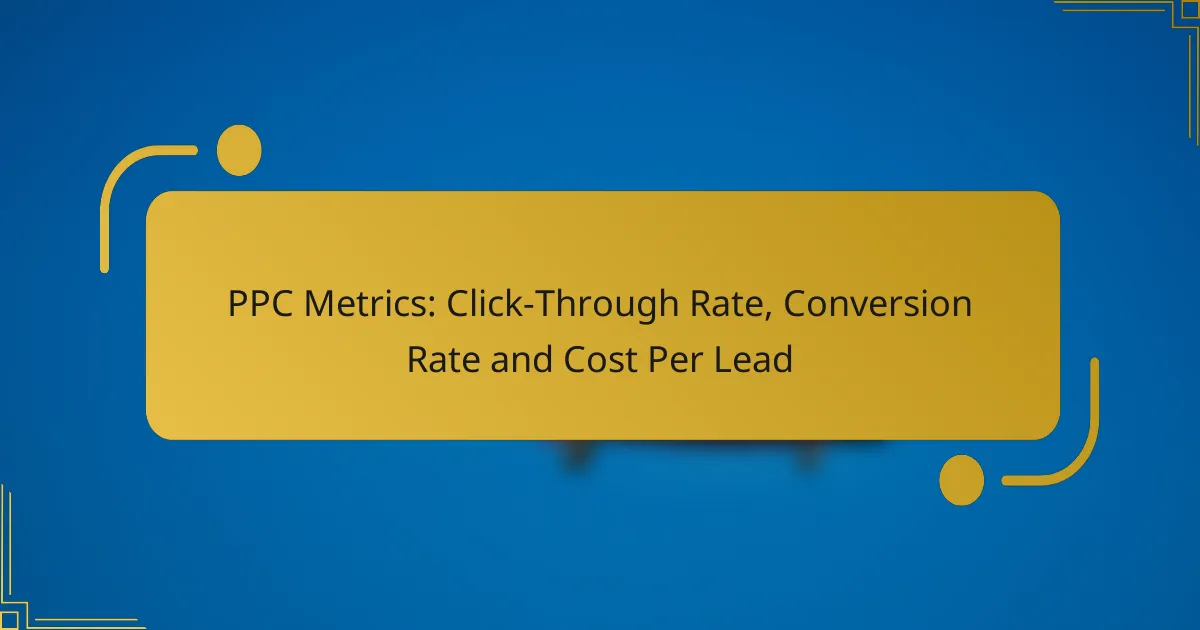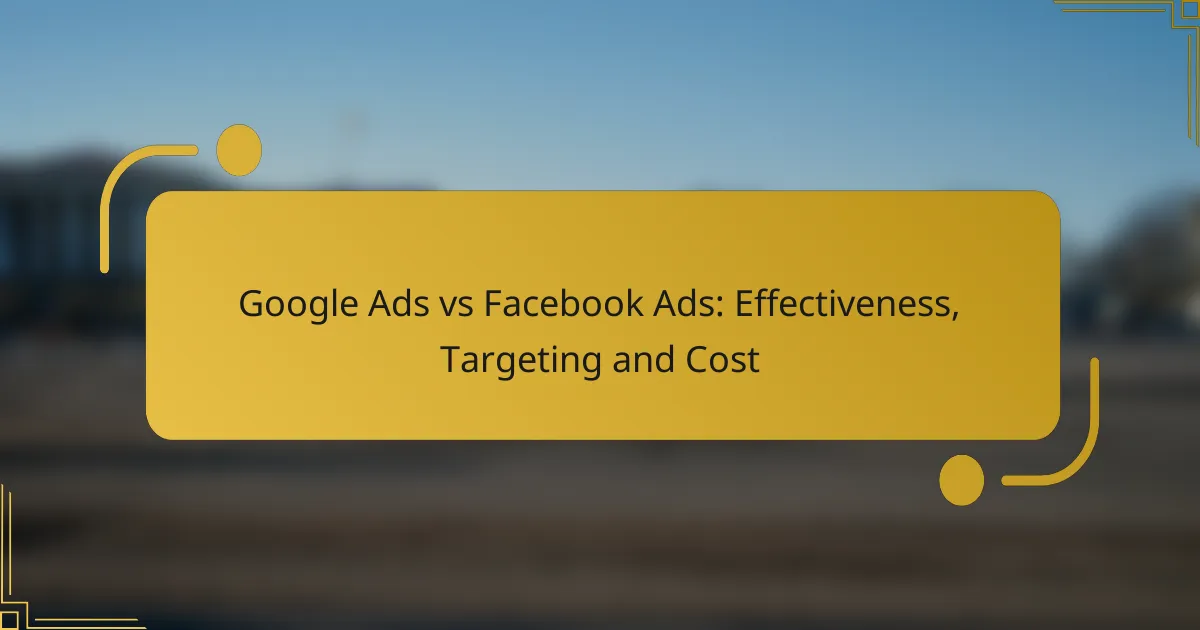Retargeting strategies are essential for maximizing advertising effectiveness by focusing on audience segmentation, ad frequency, and timing. By categorizing users based on their behaviors and preferences, marketers can deliver personalized ads that resonate with potential customers. Additionally, finding the right balance in ad frequency and timing can significantly enhance engagement and conversion rates, ensuring that messages reach the right audience at the optimal moment.
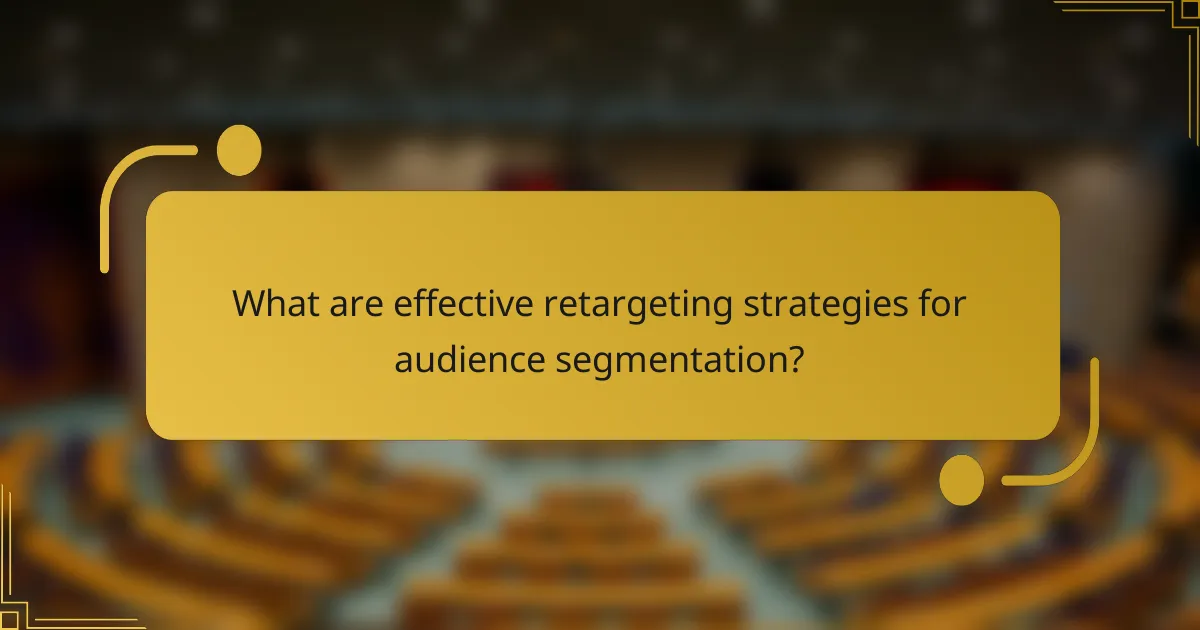
What are effective retargeting strategies for audience segmentation?
Effective retargeting strategies for audience segmentation involve categorizing users based on their behaviors, demographics, and preferences to deliver tailored ads. This approach enhances engagement and conversion rates by ensuring that the right message reaches the right audience at the right time.
Behavioral segmentation
Behavioral segmentation focuses on users’ interactions with your website or app, such as pages visited, time spent, and actions taken. By analyzing these behaviors, you can create targeted ads that resonate with users based on their interests and engagement levels. For example, if a user frequently views a specific product category, retargeting ads can highlight similar items or offer discounts to encourage a purchase.
Consider segmenting users into groups like cart abandoners, frequent visitors, or those who have engaged with specific content. This allows for more personalized messaging, increasing the likelihood of conversion.
Demographic segmentation
Demographic segmentation involves categorizing users based on identifiable characteristics such as age, gender, income level, and education. This strategy helps tailor your messaging to align with the preferences and needs of different demographic groups. For instance, a luxury brand may target higher-income individuals with exclusive offers, while a budget-friendly retailer might focus on younger consumers seeking affordable options.
Utilizing demographic data can enhance ad relevance, but be cautious not to rely solely on this method, as it may overlook individual preferences and behaviors.
Contextual segmentation
Contextual segmentation targets users based on the context in which they encounter your ads, such as the content they are currently viewing or their location. This strategy allows for real-time relevance, ensuring that ads align with users’ immediate interests. For example, displaying outdoor gear ads to users reading a travel blog can increase the chances of engagement.
To implement contextual segmentation effectively, consider the types of content your audience consumes and the timing of your ads. This approach can significantly enhance user experience and ad effectiveness.
Psychographic segmentation
Psychographic segmentation categorizes users based on their lifestyles, values, interests, and personality traits. This deeper understanding of your audience allows for highly personalized messaging that resonates on an emotional level. For example, targeting environmentally conscious consumers with sustainable product ads can foster a stronger connection and drive conversions.
To leverage psychographic data, conduct surveys or use social media insights to gather information about your audience’s preferences and motivations. This can inform your ad creative and messaging strategies.
Geographic segmentation
Geographic segmentation divides your audience based on their physical location, such as country, region, or city. This strategy is particularly useful for businesses with location-specific offerings or promotions. For instance, a restaurant chain may target ads to users in a specific city with local menu items or events.
When implementing geographic segmentation, consider local customs, languages, and preferences to ensure your ads are culturally relevant. This can enhance engagement and improve the effectiveness of your retargeting efforts.
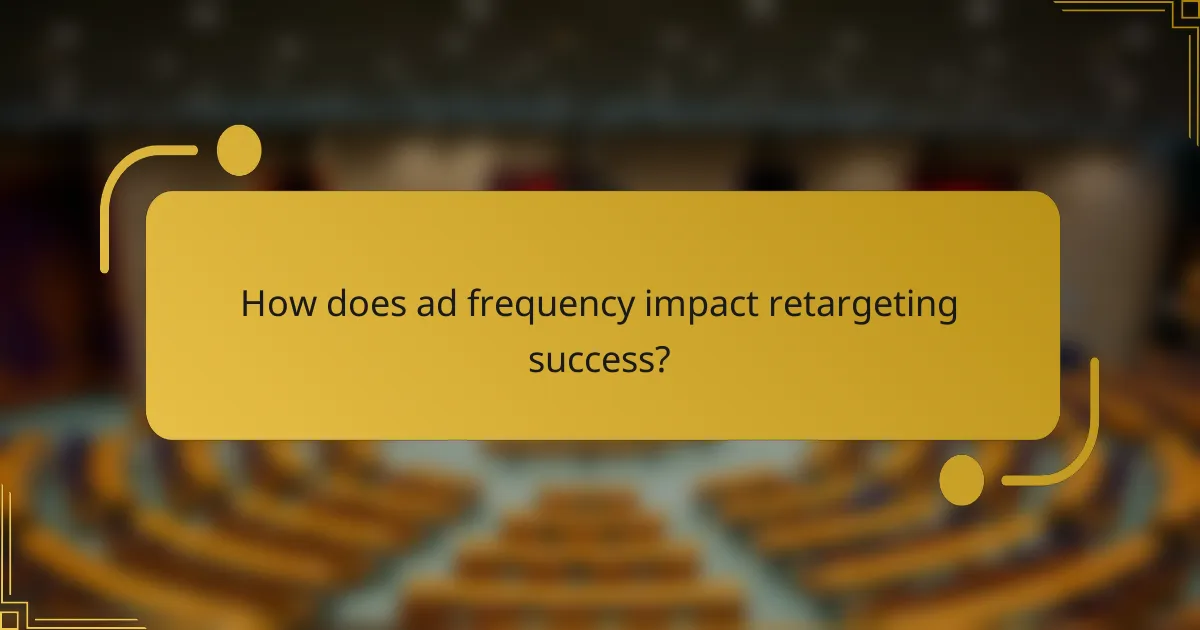
How does ad frequency impact retargeting success?
Ad frequency significantly influences retargeting success by determining how often potential customers see your ads. Striking the right balance is crucial; too few impressions may lead to missed opportunities, while excessive exposure can result in diminishing returns and ad fatigue.
Optimal frequency for engagement
The optimal frequency for engagement typically falls within the range of three to five impressions per week. This frequency allows brands to stay top-of-mind without overwhelming the audience. Testing different frequencies can help identify the sweet spot that maximizes interaction and conversion rates.
Consider segmenting your audience based on their previous interactions. For instance, users who have shown strong interest may respond well to higher frequencies, while those who are less engaged might benefit from a more moderate approach.
Frequency capping strategies
Frequency capping involves setting limits on how many times an individual sees an ad within a specific timeframe. Implementing frequency caps can help prevent ad fatigue and maintain user interest. A common strategy is to cap impressions at three to four per week for most audiences.
Utilizing dynamic frequency capping can enhance effectiveness. This approach adjusts the cap based on user engagement, allowing for more impressions for highly engaged users while limiting exposure for those who are less responsive.
Impact of ad fatigue
Ad fatigue occurs when users become desensitized to repetitive ads, leading to decreased engagement and negative brand perception. Signs of ad fatigue include declining click-through rates and increased ad avoidance. Monitoring these metrics is essential to identify when fatigue sets in.
To mitigate ad fatigue, consider refreshing your creative assets regularly and rotating different ad formats. This keeps the content engaging and can help maintain user interest over time. Additionally, adjusting your targeting strategy can introduce fresh audiences to your ads, reducing the risk of fatigue among existing viewers.

When is the best timing for retargeting ads?
The best timing for retargeting ads is crucial for maximizing their effectiveness. Ads should be displayed shortly after user interactions to capitalize on recent engagement, while also considering broader timing strategies to align with user behavior and seasonal trends.
Timing based on user behavior
Understanding user behavior is key to effective retargeting. For instance, if a user visits a product page but does not make a purchase, displaying ads within a few hours can remind them of their interest. Retargeting within 1-3 days is often effective, as users are still likely to recall their previous interactions.
Additionally, segmenting users based on their actions can enhance timing strategies. For example, users who added items to their cart but didn’t check out may respond better to ads shown within 24 hours, while those who simply browsed may require a longer interval before retargeting.
Seasonal timing considerations
Seasonal trends can significantly impact the timing of retargeting ads. For example, during holiday seasons or major sales events, users may expect to see ads more frequently and at specific times. Planning campaigns around these periods can increase visibility and engagement.
Moreover, consider the typical buying cycles for your industry. For instance, products with longer consideration phases, like electronics, may benefit from retargeting over several weeks, while fast-moving consumer goods might require more immediate follow-ups.
Time of day effectiveness
The time of day can influence the effectiveness of retargeting ads. Many users are more active during evenings and weekends, making these periods ideal for ad placements. Analyzing your audience’s online activity can help determine the best times to reach them.
Testing different times can yield insights into optimal ad performance. For example, if you find higher engagement rates in the late afternoon, prioritize your retargeting efforts during that window. Avoiding early mornings or late nights may also help reduce ad fatigue and improve overall response rates.

What tools can enhance retargeting efforts?
Several tools can significantly improve retargeting efforts by providing advanced audience segmentation, ad frequency management, and timing optimization. Utilizing these tools effectively can lead to higher engagement rates and improved conversion metrics.
Google Ads retargeting features
Google Ads offers robust retargeting features that allow advertisers to reach users who have previously interacted with their website or app. You can create custom audiences based on user behavior, such as pages visited or actions taken, which helps tailor ads to specific interests.
To optimize your retargeting campaigns, consider setting frequency caps to avoid overwhelming users with ads. A common practice is to limit impressions to a few times per week, ensuring your ads remain effective without becoming intrusive.
Facebook Ads audience tools
Facebook Ads provides powerful audience segmentation tools that enable advertisers to retarget users based on their interactions with Facebook pages, posts, or ads. You can create Custom Audiences from website visitors, app users, or even customer lists, allowing for precise targeting.
Utilizing Facebook’s Lookalike Audiences can also enhance your retargeting strategy by reaching new users who share similar characteristics with your existing customers. This can increase your chances of converting new leads into sales.
AdRoll for cross-platform retargeting
AdRoll specializes in cross-platform retargeting, allowing you to reach users across various channels, including social media, email, and display ads. This multi-channel approach helps maintain brand visibility and engagement throughout the customer journey.
When using AdRoll, take advantage of its dynamic ads feature, which personalizes ad content based on user behavior. This can lead to higher click-through rates and conversions, as users see products or services tailored to their interests.

What are the prerequisites for successful retargeting?
Successful retargeting requires a clear understanding of your audience, effective data collection, and strategic timing of ads. These elements help ensure that your campaigns are relevant and engaging, ultimately leading to higher conversion rates.
Understanding customer journey
Understanding the customer journey is crucial for effective retargeting. It involves mapping out the various stages a customer goes through, from awareness to consideration and finally to decision-making. By identifying where potential customers drop off, you can tailor your retargeting efforts to re-engage them at the right moment.
For example, if a user visits a product page but does not make a purchase, you can retarget them with ads showcasing that specific product or offering a discount. This targeted approach increases the likelihood of conversion by addressing the user’s specific interests.
Data collection and analysis
Data collection and analysis form the backbone of successful retargeting strategies. Utilize tools like Google Analytics or Facebook Pixel to gather insights on user behavior, preferences, and demographics. This data helps you segment your audience effectively, allowing for more personalized ad experiences.
Once you have collected data, analyze it to identify trends and patterns. Look for metrics such as click-through rates and conversion rates to assess the effectiveness of your ads. Regularly reviewing this data enables you to adjust your strategies based on what resonates best with your audience, ensuring your retargeting efforts remain relevant and effective.
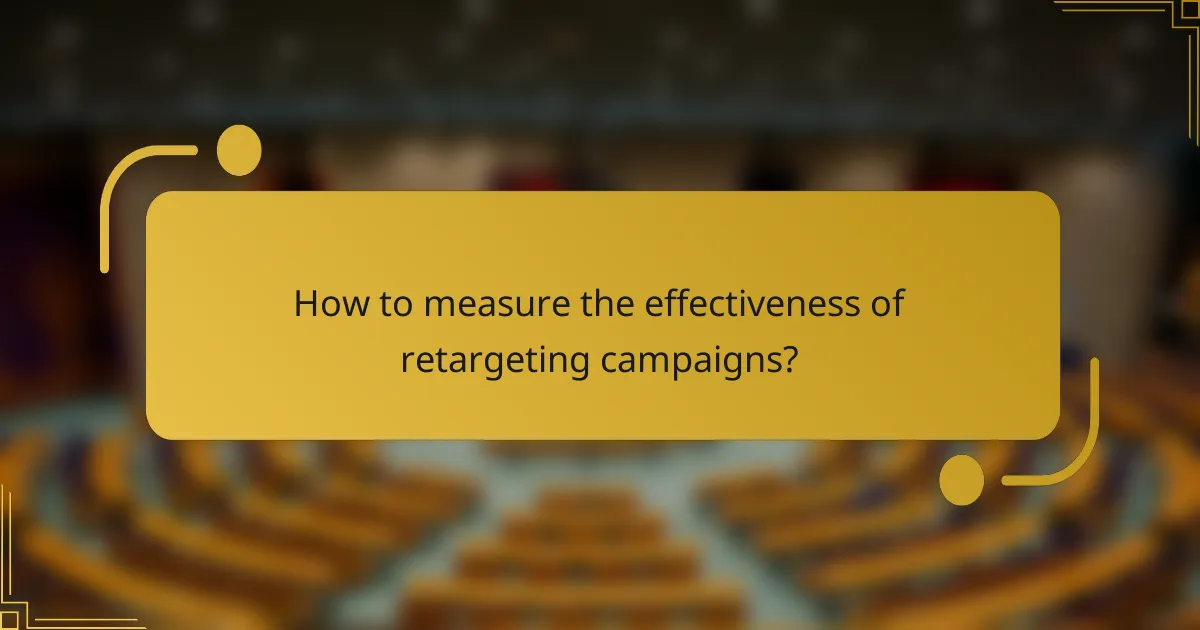
How to measure the effectiveness of retargeting campaigns?
Measuring the effectiveness of retargeting campaigns involves analyzing key performance indicators (KPIs) such as conversion rates, click-through rates, and return on ad spend. These metrics help determine how well your ads are engaging your audience and driving desired actions.
Audience Segmentation
Effective audience segmentation is crucial for optimizing retargeting campaigns. By dividing your audience into distinct groups based on behaviors, interests, and demographics, you can tailor your messaging and offers to resonate more with each segment. For instance, a fashion retailer might segment users who viewed specific categories like shoes or dresses, allowing for personalized ads that increase relevance.
To measure the impact of segmentation, track the performance of each group separately. This can reveal which segments respond best to your ads, helping you allocate resources more effectively. Aim for at least three to five segments to start, adjusting based on performance data.
Ad Frequency
Ad frequency refers to how often your target audience sees your retargeting ads. Finding the right balance is essential; too few impressions may lead to missed opportunities, while too many can cause ad fatigue. Generally, a frequency of 3-5 times per week is a good starting point for most campaigns.
Monitor engagement metrics to determine if your frequency is effective. If click-through rates drop significantly after a certain point, it may indicate that users are becoming tired of seeing the same ads. Adjust your frequency accordingly, and consider rotating ad creatives to maintain interest.
Timing
Timing plays a vital role in the success of retargeting campaigns. Understanding when your audience is most active can help you schedule your ads for maximum visibility. For example, if your target demographic is primarily working professionals, running ads during lunch hours or early evenings may yield better results.
Utilize analytics tools to assess when users engage most with your ads. This data can inform your ad scheduling strategy, allowing you to focus your budget on peak times. Experiment with different timing strategies and measure their impact on conversion rates to refine your approach over time.


